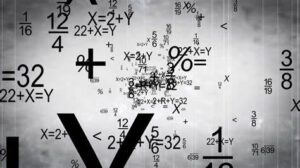Motion in a plane important IIT competitive questions.
ABCD is a parallelogram and \vec{AC}\ and\ \vec{BD}\ are its diagonals. Prove that:
(i) {\scriptsize \vec{AC}+\ \vec{BD}=2\vec{BC}\ } and
(ii) \scriptsize\vec{AC}-\ \vec{BD}\ =\vec{2AB}
Soln ) Using the triangle law of vector addition
\scriptsize\vec{AC}=\vec{AB}+\ \vec{BC}
\scriptsize\vec{BD}=\vec{BC}+\ \vec{CD}
(i) \scriptsize \vec{AC}+\ \vec{BD} = \scriptsize \vec{AB}+\ \vec{BC}+\ \vec{BC}+\ \vec{CD}
But \scriptsize \vec{AB}=\ -\vec{CD}
Therefore, \scriptsize \vec{AC}+\vec{BD}\ =\ -\vec{CD}+2\vec{BC}+\vec{CD}=\ 2\vec{BC}
(ii) \scriptsize \vec{AC}-\ \vec{BD}=\vec{AB}+\vec{BC}-\ \vec{BC}-\ \vec{CD}
= \scriptsize \vec{AB}-\ \vec{CD}=\ \vec{AB}-(-\vec{AB)}=\ 2\vec{AB}
2. A body is simultaneously given two velocities, one 30ms-1 due east and other 40ms-1 due north. Find the resultant velocity.
Soln) Let the body start moving from O,
\scriptsize \vec{V_a}=\vec{OA}=30 ms^{-1} , due east
\scriptsize \vec{V_b}=\vec{OB}=40 ms^{-1} , due north
According to parallelogram law, \scriptsize \vec{OC} is the resultant velocity.
Its magnitude is,
v = \scriptsize \sqrt{{v^2_a}+{v^2_b}} = \scriptsize \sqrt{{30}^2+{40}^2}
= \scriptsize 50 ms^{-1}
Suppose the resultant velocity \scriptsize \vec{v} makes angle β with the east direction..
Then,
tan β = \frac{CA}{OA}\ = \frac{40}{30} = 1.3333
β = \scriptsize tan^{-1} (1.3333)
= \scriptsize 53^\circ 8’
3. A particle has a displacement of 12 m towards east and 5 m towards the north and then 6 m vertically upward. Find the magnitude of the sum of these displacements.
Soln) As shown in below fig., suppose initially the particle is at origin O. Then its displacement vectors are
\scriptsize \vec{OA} = 12 m, due east
\scriptsize \vec{AB} = 5 m, due north
\scriptsize \vec{CD} = 6 m, vertically upwards.
According to polygon law, \scriptsize \vec{OC} is the resultant displacement. From right ΔOAB,
OB = \scriptsize \sqrt{{OA}^2+{AB}^2} = \scriptsize \sqrt{{12}^2+5^2}
= \scriptsize \sqrt{144+25} = 13 m
From right ΔOBC,
OC = \scriptsize \sqrt{{OB}^2+{BC}^2} = \scriptsize\sqrt{{13}^2+6^2}
= \scriptsize \sqrt{169+36} = 14.32 m
4. Two forces of 5 N and 7 N act on a particle with an angle of 60o between them. Find the resultant force.
Soln) Here P = 5 N, Q = 7 N, θ = 60O
The magnitude of the resultant force is
R = \scriptsize \sqrt{P^2+\ Q^2\ +{\ 2\ PQ\ cos\theta\ }}
= \scriptsize \sqrt{5^2+\ 7^2\ +{\ 2\ \times5\ \times7\ \times c\ o\ s\ 60}^o}
= \scriptsize \sqrt{109} = 10.44 N.
If \scriptsize \vec{R} makes angle β with the force \scriptsize \ \vec{P} , then
tan β = \frac{Q\sin{\theta}}{P+Q\cos{\theta}} = \frac{7\sin{{60}^o}}{5+7\cos{{60}^o}} = 0.7132
Or, β = tan-1 0.7132
= \scriptsize 35^\circ29’
5. Two vectors, both equal in magnitude, have their resultant equal in magnitude of the either. Find the angle between the two vectors.
OR
Two equal forces have their resultant equal to either. What is the inclination between them ?
Soln) Here P = Q = R
As, R = \scriptsize \sqrt{P^2+\ Q^2\ +{\ 2\ PQ\ cos\theta\ }}
Therefore,
P = \scriptsize \sqrt{P^2+\ P^2\ +{\ 2\ P.P\ cos\theta\ }}
or \scriptsize P^2 = 2P^2 (1 + cos θ)
or 1 + cos θ = \frac{1}{2}
or cos θ = \frac{1}{2} = \scriptsize cos 120^o
or cos θ = −\frac{1}{2} = \scriptsize cos 120^o
or θ = \scriptsize 120^o.
6. Two forces whose magnitudes are in the ratio of 3:5 give a resultant of 35 N. If the angle of inclination be 60o, calculate the magnitude of each force.
Soln) Let P = 3x newton, Q = 5x newton,
R = 35 N, θ = 60^o
R = \scriptsize \sqrt{P^2+\ Q^2\ +2PQ\cos{\theta}}
Or 35 = \scriptsize \sqrt{{(3x)}^2+\ {(5x)}^2\ +{\ 2\ \times3x\ \times5x\ \times cos60}}
Or 35 = 7x
Or x = \frac{35}{7} = 5
Therefore,
P = 3 \times 5 = 15 N
And Q = 5 \times 5 = 25 N.
7. Two forces equal to P and 2 P newton act on a particle. If the first be doubled and the second be increased by 20 newton, the direction of the resultant is unaltered. Find the value of P.
Soln) Let the resultant make angle β with the force P.
Therefore in first case,
tan β = \frac{2\ P\sin{\theta}}{P+2\ P\cos{\theta}}
In second case,
tan β = \frac{(2\ P+20)\sin{\theta}}{2\ P+(2\ P+20)\cos{\theta}}
Hence,
\frac{(2\ P+20)\sin{\theta}}{2\ P+(2\ P+20)\cos{\theta}} = \frac{2\ P\sin{\theta}}{P+2\ P\cos{\theta}}
Or \frac{2\ P\sin{\theta}}{P+2\ P\cos{\theta}} = \frac{{20}\sin{\theta}} {P+20\cos{\theta}} \left[ {\scriptsize\because}\ \frac{a}{b}\ =\ \frac{c}{d}\ =\ \frac{a\ -\ c}{b\ -\ d}\ \right]
From the above equation,
2 P = 20
P = 10 N.
8. The greatest and the least resultant of two forces acting at a point are 29 N and 5 N respectively. If each force is increased by 3 N, find the resultant of two new forces acting at right angle to each other.
Soln) Let P and Q be the two forces. Then,
Greatest resultant = P + Q = 29 N ….(i)
Least resultant = P – Q = 5 N ….(ii)
On solving (i) and (ii), we get
P = 17 N, Q = 12 N
When each force is increased by 3 N, new forces are
p = P + 3 = 17 + 3 = 20 N
q = Q + 3 = 12 + 3 = 15 N
As the new forces act at right angle to each other, their resultant is
R = \sqrt{p^2+q^2} = \sqrt{{20}^2+{15}^2} = \sqrt{625} = 25 N
If the resultant R makes angle β with the force p, then
tan β = \frac{p}{q}\ =\ \frac{15}{20}\ =\ 0.75\
or β = tan^{-1}(0.75) = 36^o52’ .
9. The sum of the magnitudes of two forces acting at a point is 18 N and the magnitude of their resultant is 12 N. If the resultant makes an angle of 90o with the force of smaller magnitude, what are the magnitude of the two forces ?
Soln) Let the two individual forces be \vec{P} and \vec{Q} and \ \theta\ be the angle between them. Let P < Q. If the resultant makes angle β with the force \vec{P} , then
tan β = \frac{Q\ \sin{\theta}}{P+\ Q\cos{\theta}}
But β = 90^o
Therefore,
\frac{Q\ \sin{\theta}}{P+\ Q\cos{\theta}} = tan 90^o = ∞
Or P + Q cos θ = 0
Also P + Q = 18 N
As R = \sqrt{P^2+\ Q^2\ +2\ PQ\cos{\theta}} = 12
Therefore,
P^2 + Q^2 + 2 PQ cos θ = 144
Or P^2 + (18 - P)^2 + 2 P(- P) = 144 [ therefore, Q = 18 – P, Q cos θ = − P ]
Or P^2 + (324 + P^2 – 36 P)− 2P^2 = 144
Or 6 P = 180
Or P = 5 N
And Q = 18 – 5 = 13 N.
10. A motorboat is racing towards north at 25 km h-1 in the direction of 60o east of south. Find the resultant velocity of the boat.
Soln) Let the motorboat start moving from O, as shown in below fig.,
\vec{V_b} = velocity of motorboat
= 25kmh^{-1} , due north
\vec{V_c} = velocity of water current
= 10kmh^{-1} , 60^\circ east to south
By parallelogram law, the resultant velocity \vec{v} is equal to the diagonal \vec{OC.}
Its magnitude is
v = \sqrt{{v^2_b}+{v^2_c}+ 2{v_b}\ {v_c} cos120^\circ}
= \sqrt{{25}^2+\ {10}^2\ +{\ 2\ \times25\ \times10(-\frac{1}{2})}}
= 21.8 km h^{-1}
Suppose the resultant velocity \vec{v}\ makes angle β with the north direction. Then
tan β = \frac{{V_c}\ sin120^\circ} {{V_b}\ +\ {V_c}\ cos120^\circ} = \frac{10\ \times(\sqrt3/2)}{25\ +\ 10\ \times(-1/2)\ }
= {\frac{\sqrt3}{\ 4}}
= 0.433
β = tan^{-1}(0.433) = 23.4^o
11. On a certain day, rain was falling vertically with a speed of 35 ms-1 . A wind started blowing after some time with a speed of 12 ms-1 in east to west direction. In which direction should a boy waiting at a bus stop hold his umbrella ?
Soln)
Velocity of rain,
\vec{V_r}=\vec{OA}=35\ ms^{-1} , vertically downward
Velocity of wind,
\vec{V_w}=\vec{OB}=12\ ms^{-1} , east to west.
Lorem ipsum dolor sit amet, consectetur adipiscing elit. Ut elit tellus, luctus nec ullamcorper mattis, pulvinar dapibus leo.


